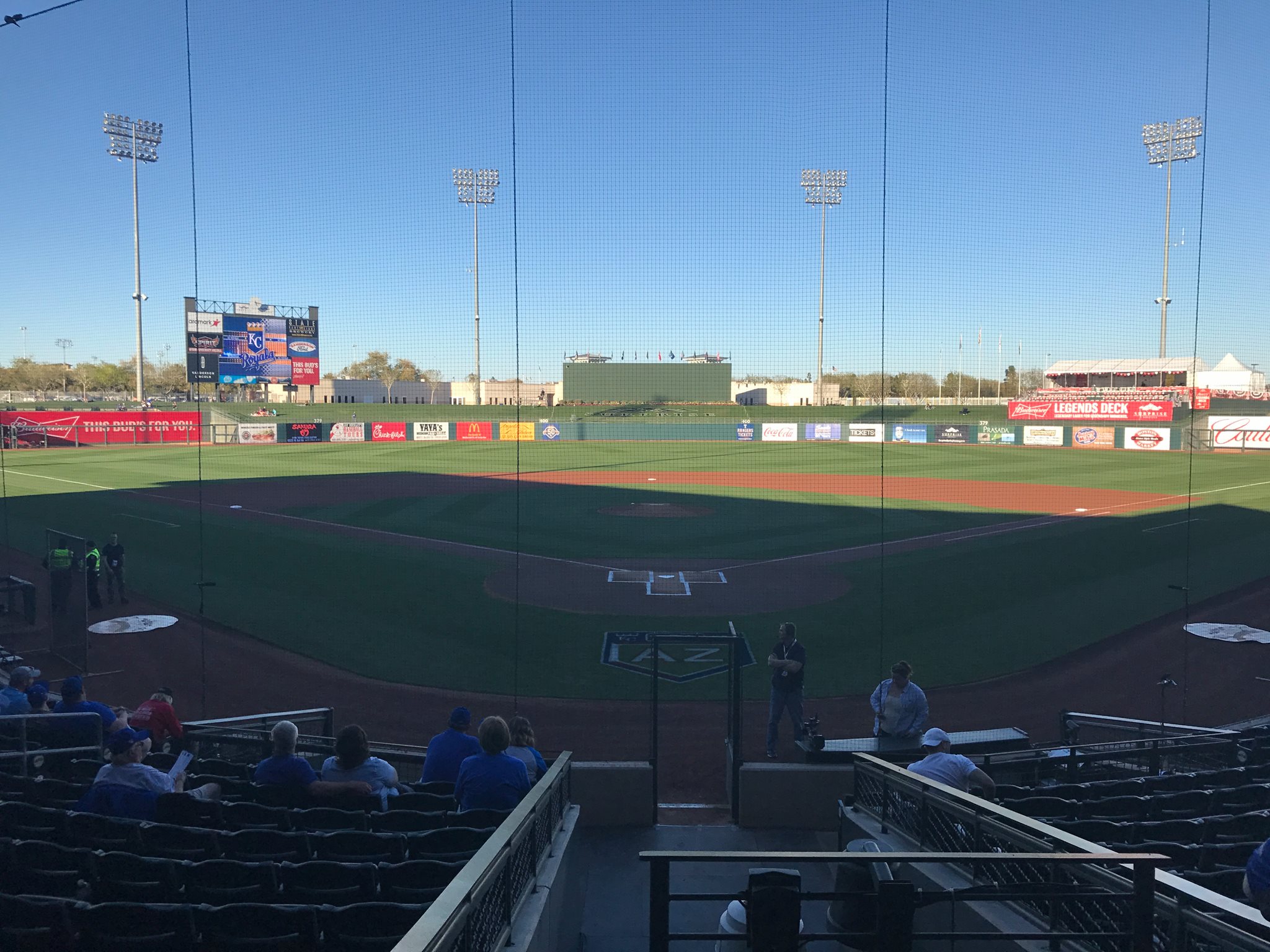

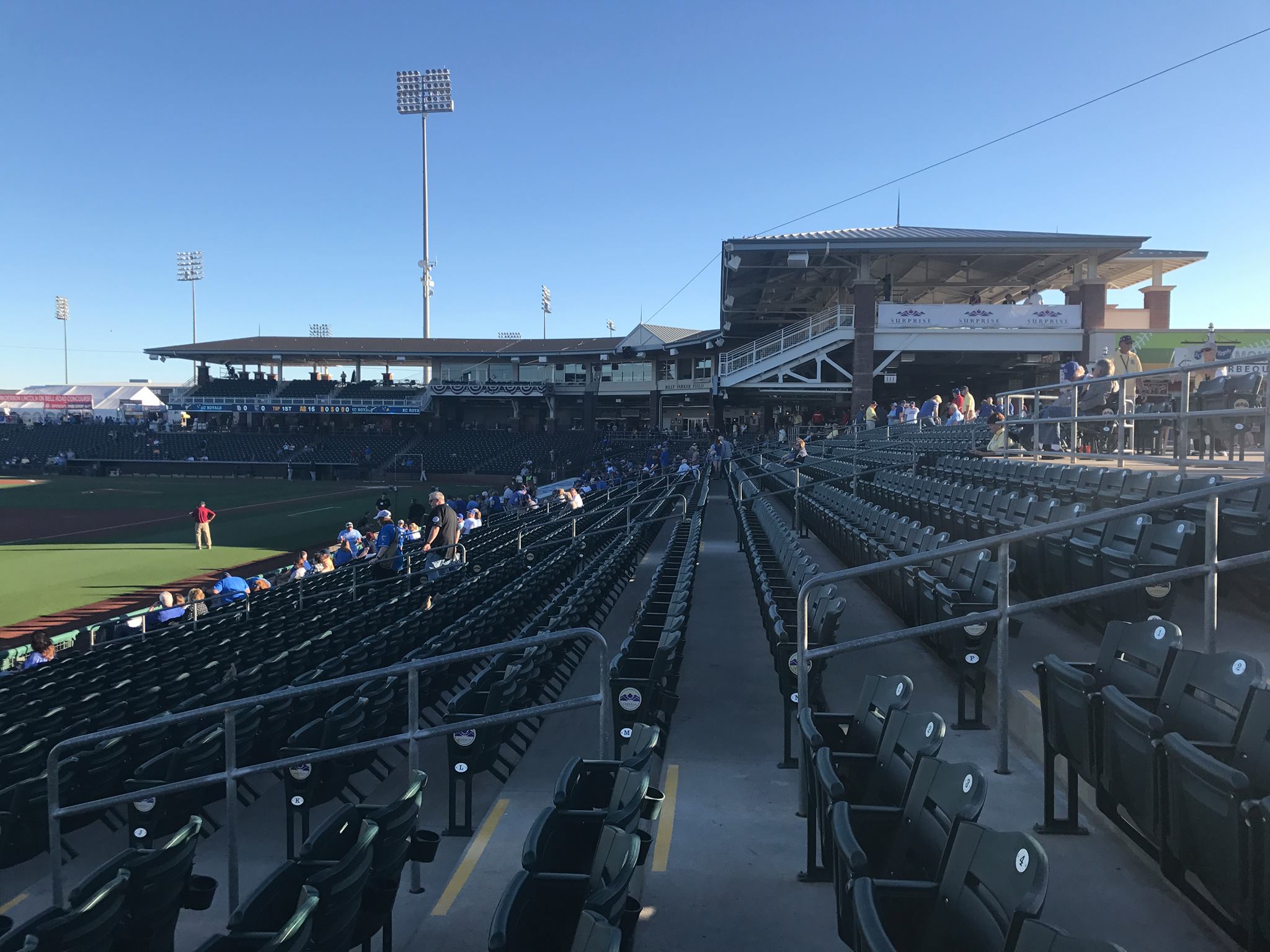
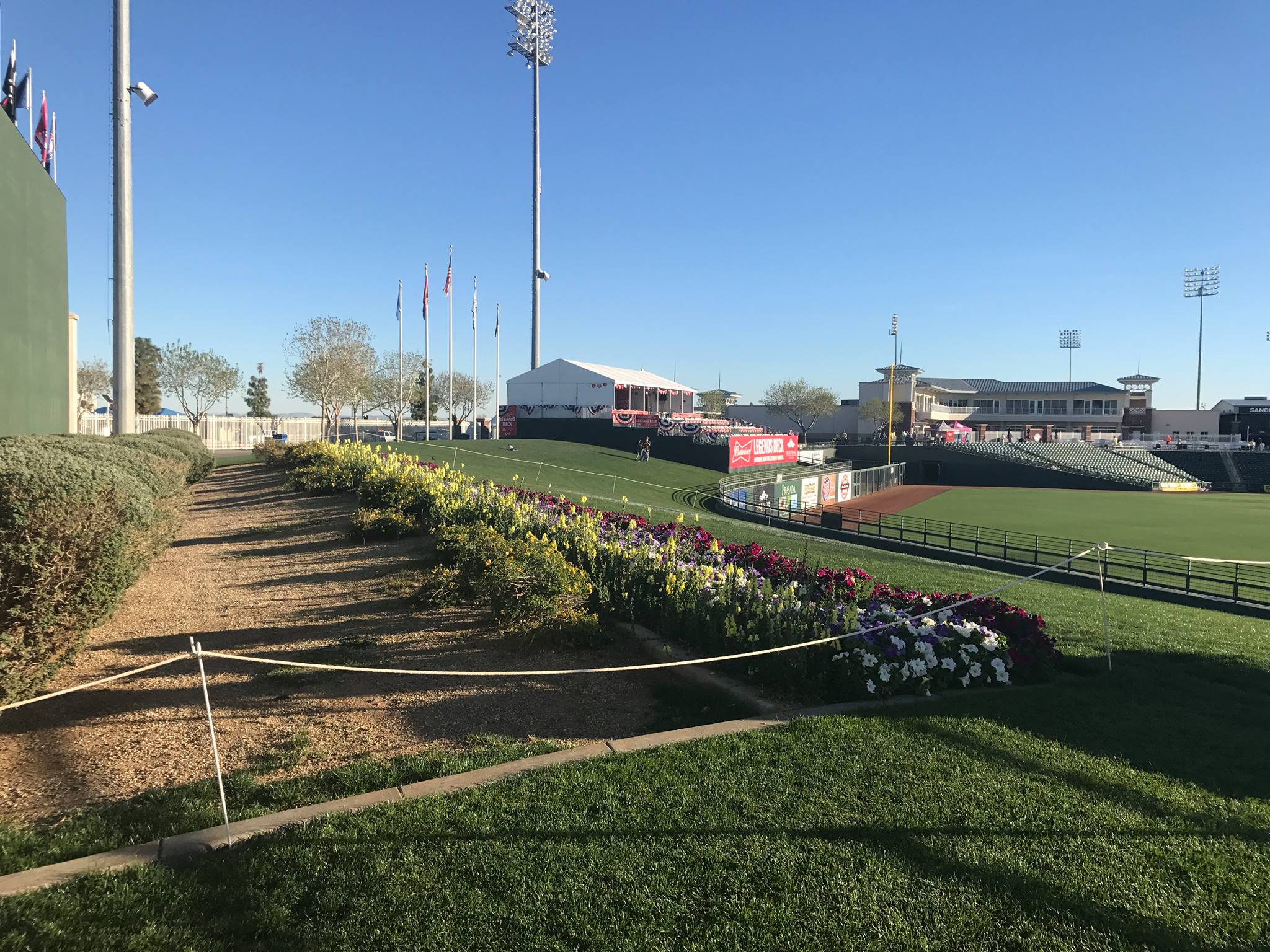
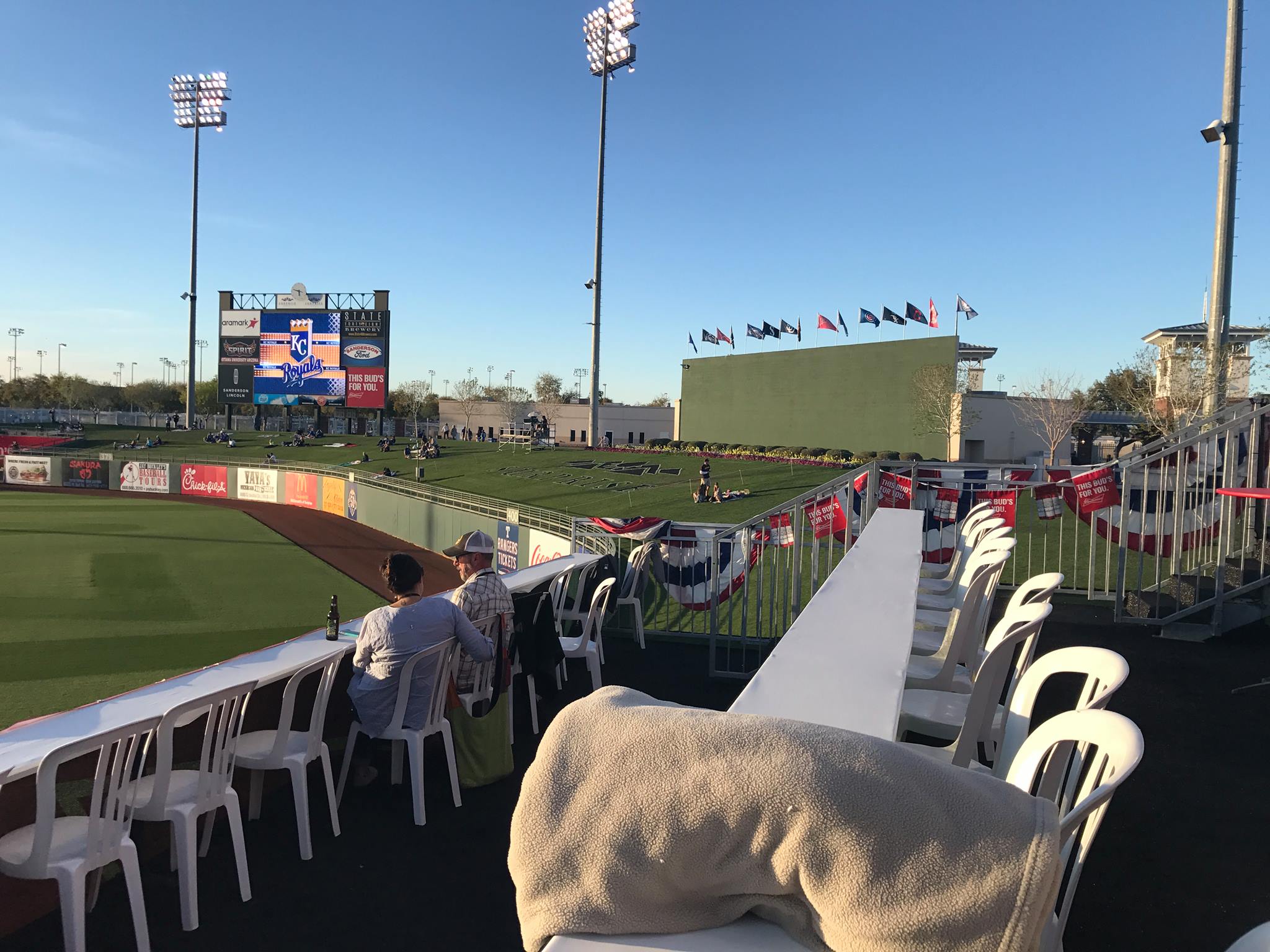


Surprise Stadium
| Setting | 8/10 | 1 Thumb Up | Location/Access | 8/10 | 1 Thumb Up |
|---|
| Architecture & Aesthetics | 21/28 | Thumb Sideways |
|---|---|---|
| Exterior Design/Aesthetics | 6/10 | 1 Thumb Down |
| Interior Aesthetics/Visuals | 12.5/15 | 1 Thumb Up |
| Concourse Aesthetics | 2.5/3 | 1 Thumb Up |
| Functionality & Essentials | 20.5/25 | 1 Thumb Up |
|---|---|---|
| Sightlines | 7.5/10 | Thumb Sideways |
| Seat Comfort | 4/5 | 1 Thumb Up |
| Concourse Functionality | 6.5/7 | 1 Thumb Up |
| Scoreboards/Tech | 2/3 | Thumb Sideways |
| Amenities & Features | 11/20 | 1 Thumb Down |
|---|---|---|
| Concessions | 8/10 | Thumb Sideways |
| Premium/Group Seating | 1.5/4 | 1 Thumb Down |
| Social Spaces | 1/4 | 1 Thumb Down |
| Kids Areas | 0/2 | 1 Thumb Down |
| Atmosphere, Vibe, & Policies | 12.5/17 | 1 Thumb Down |
|---|---|---|
| Ballpark Personality | 7/10 | Thumb Sideways |
| Fan Support | 3.5/5 | Thumb Sideways |
| Ballpark Policies/Staff | 2/2 | 1 Thumb Up |
| Bonus | 8 |
|---|---|
| Final Score | 80 |
|---|---|
| Ranking | AZ: #9/10; Overall: #21/23 |
|---|---|
By: Cole Shoemaker
Opening for spring training in 2003 to the tune of $48 million, nearly double the cost of similarly acclaimed complexes years before, Surprise Stadium set the new industry standard.
Dazzling people with an appropriately southern-esque Kentucky Derby-like architectural vibe, it featured a wonderfully unique open concourse design integrated with team clubhouses and batting cages, accompanied by a small mezzanine emulating the major league parks.
With the exception of the most recent new parks in Arizona, spring training venues are historically adept at outdoing each other in a shockingly short amount of time. I think that’s what most likely happened here.
Regardless, I’ve always been underwhelmed by Surprise Stadium, in what’s my most contrarian spring training ballpark ranking.
While aesthetically charming, especially intimate, and still pretty functional, out of all the Cactus League parks I explored during my 2011 trip to Arizona, Surprise was easily the most forgettable.
Moreover, during our 2018 trek, not only had Surprise Stadium not been improved, but I felt that the park had actually gotten worse in some respects. As I’ll illustrate, the amenities demonstrably aren’t up to snuff in 2020, as my misgivings are in categories that can be objectively quantified. Don’t get me wrong: Surprise Stadium is a fine ballpark, but I just don’t see it as a particularly great one.
Located 23 miles northwest of downtown Phoenix, Surprise Stadium is the most remotely situated of all spring parks in the Valley. On the plus side, the local scene is pretty nice, although it’s more geared toward the community than fans, as this is no “ballpark village.”
Surprise Stadium anchors the Surprise Recreational Campus, a diverse 132-acre complex serving many of the city’s needs. Adjacent to the practice fields, there is a library, community park, tennis and racquet complex, and aquatic center. There are also multiple golf courses down the road.

The unusual layout of the complex in relation to Surprise Stadium might be the most memorable part of the experience, and it dictates the architectural and aesthetic sensibility of the entire setup.
The design is quite novel and creative, but it’s not a plus for the exterior design. Fans enter and exit the ballpark in the outfield, as the outside parameters spanning the infield are restricted. While this allows for the integration of batting cages and clubhouses on the far side of the main concourse, fans don’t get an immediate sense of arrival when entering Surprise Stadium because they cannot access the bulk of the facade. Outfield gates only.
So, Surprise Stadium has no pretentions of trying to have a groundbreaking exterior, even on a literal level as most of it is hidden from fan view. The exterior façade around the outfield gates that fans do see is totally unremarkable by today’s standards.
Surprise Stadium’s interior aesthetics are significantly stronger. For one, I applaud the architects for eschewing the traditional southwestern Arizona motif, in favor of something that fits the two teams that play here. The structure behind home plate is unmistakably Southern, with a white picket style roof and clay brick columns that fit Texas and Kansas City. In addition, the outfield aesthetics are fairly attractive, if not a bit forgettable. The highlight is the hill in center field recalling Globe Life Park in Arlington (RIP!). In recent years, the complex added plants and a cactus in front of the batter’s eye.
Unfortunately, other than the Brewers park, this ballpark has the fewest mountain view points in the Valley.
As with most shared complexes, Surprise Stadium doesn’t otherwise do a good job of representing the teams that play here, but it’s a step above some others because of the aesthetic features that remind fans of home. There is a Hall of Fame plaque area honoring players on the main concourse behind home plate. The outfield mileage signs pointing out the distance from Surprise to Arlington and Kansas City is a nice touch. Although as I outlined at the beginning, it comes off as a pretty generic facility today.
Surprise Stadium is still a fine ballpark from a functional point of view. Out of all of the larger, newer 10,000+ seat venues in Arizona, Surprise feels perhaps the most intimate for watching a game. But there are a few sections down the lines that aren’t properly oriented toward the infield, which is unacceptable for even 2003. All seats are of the fold down variety and possess cupholders. The videoboard is good.
The ballpark also maintains one of the best 360-degree concourses. Sufficient in width and open to the field from almost every vantage point, there are plenty of great standing room areas as well. Conceptually, the concourse design integrating batting cages and clubhouses on the far side is both fan-friendly and clever, so bonus points for that.
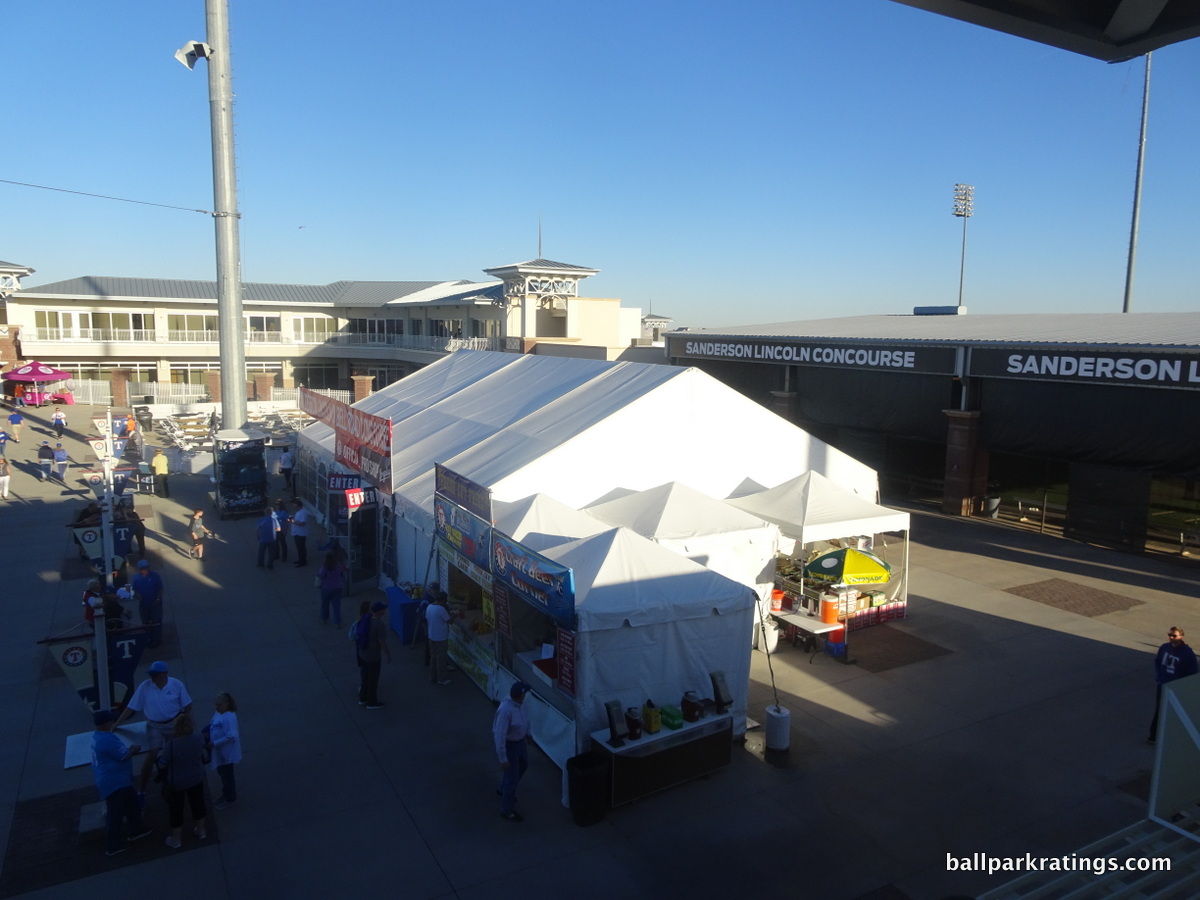
The concessions are average, perhaps a bit below-average for the Cactus League. Regular stands behind home plate are more value oriented, with specialty options like BBQ, Mexican, Chick-fil-A, and Pork Tenderloin down the left field line.
With its wide concourses, the ballpark has a lot of space, but fails to do much with it. It may be helpful to compare Surprise to other spring parks across Arizona with photos (and I could do Florida too).
The park completely lacks in places to sit down or hang out, other than a small number of picnic tables down the lines. Earlier in the decade, the park had a dedicated picnic area down the right field line, but that has been replaced by a perfunctory team store. The park lacks the social spaces accessible to all on the concourses as well. Surprise has none of fun bars like Salt River, Glendale, Mesa (Cubs), Goodyear, or even Tempe.
Surprise Stadium also notably lacks the unique seating options, quality group areas, or premium spaces of other parks. Whether a group area or club seating, note the attractive set ups on the mezzanines in Salt River, Glendale, Mesa (Cubs), Peoria, or even Scottsdale compared to the set up here, where employee break seating occupies that space.
Note a typical concourse hospitality area like in Mesa (Athletics) compared to the group area here.
Spring training parks frequently have private outfield “party decks” as well. Note the arrangement in places like Scottsdale and Goodyear compared to the rudimentary area here. Only the six aging luxury suites are of note. Finally, Surprise Stadium got rid of its kitschy merry-go-round, so there’s nothing extra for the kids.
All of this is to say Surprise Stadium is manifestly behind the curve in spring training when it comes to those extra fan-friendly amenities, and it actually got a little bit worse compared to a decade ago. Only the Brewers park and Tempe are similarly lacking in this department.
Of course, amenities are a small factor, and Surprise Stadium is still a place I very much enjoy. In fact, my guess is the vast majority of readers don’t care about this at all.
But these aspects can separate the good (yes, ranking #21/23 in spring training is still “good,” all spring training parks have improved so much in the last 20 years) from the great. Amenities also become even more salient at a place like Surprise Stadium because it otherwise lacks in distinguishing features compared to the newer, state-of-the-art concepts, charming older facilities with vibrant atmospheres, or otherwise ordinary ballparks that represent the teams that inhabit them.